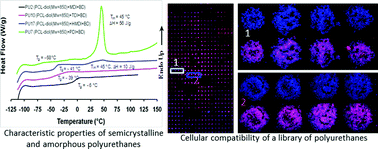Synthesis and cellular compatibility of multi-block biodegradable poly(ε-caprolactone)-based polyurethanes†
Abstract
A library of

* Corresponding authors
a
School of Chemistry, University of Edinburgh, Kings Buildings, West Mains Road, Edinburgh, UK
E-mail:
ferdous.khan0@gmail.com
b Ecole Nationale Superieure de Chimie de Montpellier, 8Rue de l'Ecole Normale, 34296 Montpellier Cedex 5, France
c Institute of Chemical Sciences, Heriot-Watt University, Edinburgh, UK
A library of

 Please wait while we load your content...
Something went wrong. Try again?
Please wait while we load your content...
Something went wrong. Try again?
F. Khan, S. Valere, S. Fuhrmann, V. Arrighi and M. Bradley, J. Mater. Chem. B, 2013, 1, 2590 DOI: 10.1039/C3TB00358B
To request permission to reproduce material from this article, please go to the Copyright Clearance Center request page.
If you are an author contributing to an RSC publication, you do not need to request permission provided correct acknowledgement is given.
If you are the author of this article, you do not need to request permission to reproduce figures and diagrams provided correct acknowledgement is given. If you want to reproduce the whole article in a third-party publication (excluding your thesis/dissertation for which permission is not required) please go to the Copyright Clearance Center request page.
Read more about how to correctly acknowledge RSC content.
 Fetching data from CrossRef.
Fetching data from CrossRef.
This may take some time to load.
Loading related content
